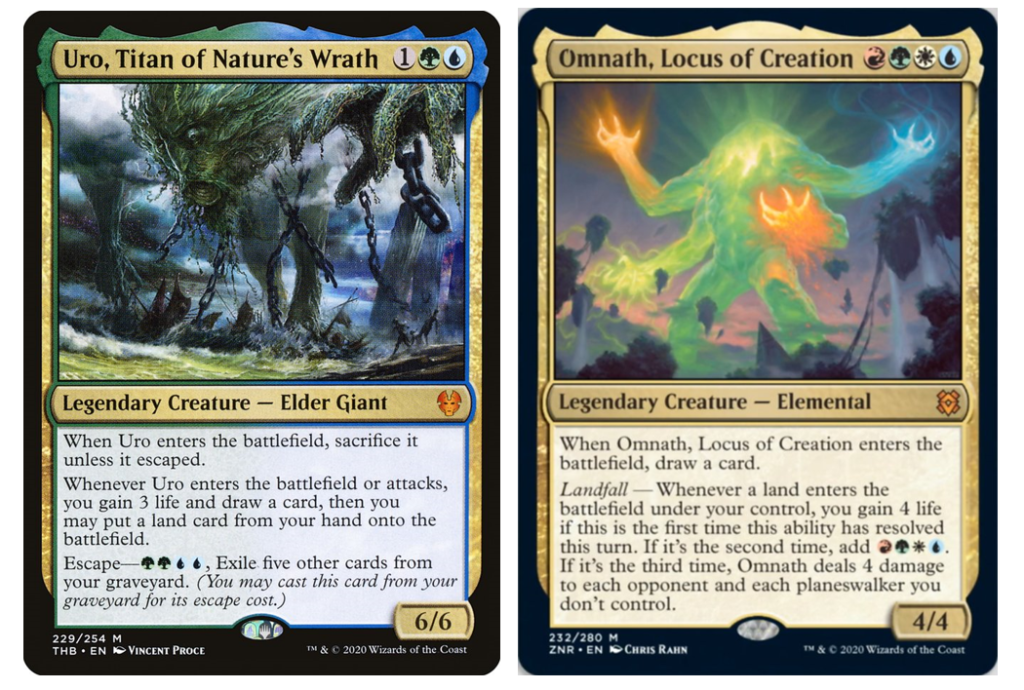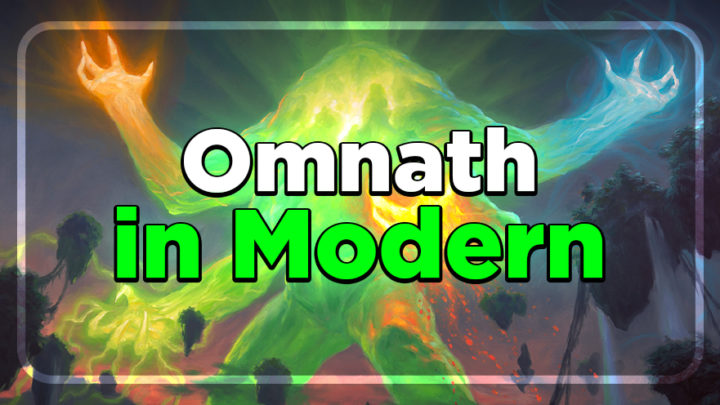Hmm, I think I’ve seen this one before: “Flagship Standard Mythic Becomes High Level Modern Staple.”

That’s right! Just like Uro, Titan of Nature’s Wrath, Omnath, Locus of Creation has quickly become a fixture of the Modern format. As Omnath cares about multiple landfall triggers per turn, it’s a natural ally for Uro, who makes it easy to enable all three Omnath triggers (especially in a format that prominently features fetchlands).
Surely not many decks are going to be interested in Omnath because of the four-color casting cost…but which decks are? Not surprisingly, the two primary homes seem to be Four-Color Uro and Five-Color Niv. Uro decks were primarily Bant in the first place — often splashing red for Wrenn and Six — and Five-Color Niv certainly already had the tools to reliably cast Omnath. Let’s take a look at both of these decks — how they’re built, and how to beat them.
Four-Color Uro
Four-Color Uro by Jonathan Hobbs | 3rd Place, NRG Qualifier

3 Omnath, Locus of Creation
3 Uro, Titan of Nature’s Wrath
2 Teferi, Hero of Dominaria
3 Teferi, Time Raveler
3 Wrenn and Six
3 Cryptic Command
3 Force of Negation
3 Growth Spiral
1 Lightning Bolt
3 Mana Leak
4 Path to Exile
1 Breeding Pool
1 Field of Ruin
2 Field of the Dead
4 Flooded Strand
1 Forest
1 Hallowed Fountain
1 Island
1 Ketria Triome
4 Misty Rainforest
2 Mystic Sanctuary
1 Raugrin Triome
4 Scalding Tarn
1 Snow-Covered Forest
1 Snow-Covered Island
1 Snow-Covered Plains
1 Steam Vents
1 Temple Garden
Sideboard:
3 Aether Gust
3 Celestial Purge
2 Cleansing Wildfire
1 Firespout
2 Mystical Dispute
1 Supreme Verdict
1 Timely Reinforcements
2 Veil of Summer
Four-Color Uro functions as a cross between a ramp deck and a control deck. On the surface, Four-Color Uro seems to be missing the traditional ramp payoffs, but the secret is Field of the Dead will reward you for putting a lot of lands into play quickly.

Before we get too into the nuts and bolts of this deck, I want to talk about a concept called “power spikes” that is critical to understanding ramp decks. Ramp decks intentionally skip spots on the curve in order to get the most power out of being up a mana on the opponent. These skips are usually one to three, two to four, and three to five, and they result in huge spikes of power for ramp decks.
The power spike in Four-Color Uro comes at five mana, where you’re able to cast Teferi, Hero of Dominaria to bury the opponent in cards and mana. Hour of Promise finding Field of the Dead is also a powerful five-mana play. Primeval Titan may seem conspicuously absent here, but its six-mana casting cost is a big disqualifier. Ramp decks have to pick their power spikes, which are usually one to three, two to four, and three to five. You’re also unlikely to find one-mana accelerators in Four-Color Uro because the main plan is to win the game on card quality, and cheap mana creatures don’t scale well as the game progresses.

Instead, this deck uses Growth Spiral, which provides the opportunity to jump from two to four mana. Instant speed lets you hold up Mana Leak should you need it, and because Growth Spiral allows you to put untapped lands into play, you can use the third mana for a Lightning Bolt or Path to Exile. The ability to curve a Growth Spiral plus a removal spell on turn two into a Jace, the Mind Sculptor on turn three ensures that you untap with the powerful Planeswalker.

Meanwhile, Uro lets you jump from three to five mana with relative ease, which is important for Omnath. While Omnath is a four-drop, one of the most powerful spots to deploy it is on turn four before you play your land, thanks to the acceleration provided by Uro. This sequence turns your fetchland into three life and WURG mana — which, in conjunction with the land you played, allows you to cast Hour of Promise or Teferi, Hero of Dominaria. If you do cast Hour of Promise using the mana from Omnath, you’ll likely end up with three life, four damage to the opponent and each Planeswalker they control, two 2/2’s from Field of the Dead…oh, and Omnath also drew a card.

The rest of the deck consists of traditional control elements to help you close out the game. Cryptic Command, Mystic Sanctuary, and Uro will lock someone out of the game without much effort. Path to Exile, Lightning Bolt, Wrenn and Six, and Teferi, Time Raveler will handle early creatures and give you enough time to reach the late game, where Four-Color Uro is among the best in Modern.
Five-Color Niv
5c Niv by GodOfSlaughter, 5th place MTGO Challenge

3 Teferi, Time Raveler
4 Wrenn and Six
3 Ice-Fang Coatl
3 Niv-Mizzet Reborn
3 Omnath, Locus of Creation
4 Stoneforge Mystic
3 Uro, Titan of Nature’s Wrath
3 Bring to Light
1 Dreadbore
1 Supreme Verdict
1 Abrupt Decay
1 Assassin’s Trophy
4 Kaya’s Guile
1 Kolaghan’s Command
4 Lightning Helix
1 Batterskull
1 Sword of Feast and Famine
1 Sword of Fire and Ice
4 Abundant Growth
4 Utopia Sprawl
1 Breeding Pool
1 Godless Shrine
1 Indatha Triome
1 Ketria Triome
4 Misty Rainforest
1 Overgrown Tomb
4 Prismatic Vista
2 Snow-Covered Forest
1 Snow-Covered Island
1 Snow-Covered Mountain
1 Snow-Covered Plains
1 Snow-Covered Swamp
1 Steam Vents
1 Stomping Ground
1 Temple Garden
1 Verdant Catacombs
4 Windswept Heath
3 Wooded Foothills
Sideboard:
2 Ashiok, Dream Render
1 Boil
1 Crumble to Dust
3 Fatal Push
1 Fulminator Mage
1 Gaea’s Blessing
1 Klothys, God of Destiny
2 Unmoored Ego
2 Veil of Summer
1 Yorion, Sky Nomad
Five-Color Niv has been on the fringes of Modern for some time, always just short of becoming a contender. These decks have always been piles of the best cards by virtue of having access to a functional five-color mana base, but figuring out which cards to play has been challenging. There are a couple of versions floating around: one with Yorion, Sky Nomad and one without. Recently, GodOfSlaughter put up a 7-0 run during the Swiss rounds of a MTGO Challenge before taking a loss in the quarterfinals with the Yorion version above.
Five-Color Niv doesn’t have all of Four-Color Uro’s controlling elements, but it does look to go over the top of every midrange deck in Modern based on sheer card quality. Trading one-for-one is the name of the game for classic midrange decks, but not Five-Color Niv; many of its cards will trade for an opponent’s card and gain a slight advantage (Lightning Helix is a great example). This lets you get slightly ahead of the opponent until you play a Niv-Mizzet Reborn and slam the door by refueling your hand with spells.

Omnath also adds some cool tricks to Five-Color Niv. If you take the same “turn three Uro into turn four Omnath” line we discussed above, you can put a fetchland that finds black mana into play and cast a Niv-Mizzet Reborn in the same turn, which will often be too much for opponents to come back from. Converting WURG mana plus one from your land drop makes it fairly easy to cast ten mana worth of spells on your Omnath turn, which is backbreaking against most decks.

Five-Color Niv has eight one-mana accelerants in Abundant Growth and Utopia Sprawl, which gives this list a total of eleven ways to power out a turn three Omnath, or a turn four Omnath plus a land. The power spike from one to three doesn’t matter much in this version of Five-Color Niv, but the consistency with which you can cast Omnath and Niv-Mizzet Reborn ahead of schedule matters quite a bit.

Yorion, Sky Nomad gives you a way to try and go over other midrange decks and gives you an edge in the mirror. With a staggering 28 cards that benefit from being blinked (either “enter the battlefield” effects or loyalty resets on Planeswalkers), Yorion is going to provide an enormous influx of cards. Paying three mana and then another five to play Yorion is a tall task for most decks, but with the amount of acceleration and mana generation that Five-Color Niv has, paying the companion tax shouldn’t be much of a problem.
How to Beat Omnath Decks
We know these two decks are powerful, but how do we beat them? While they may function similarly and share some common weaknesses, beating each deck requires a different approach.

The best way to beat Four-Color Uro seems to be by going under it, via either combat or combo. An aggressive start from Rakdos Shadow can run Four-Color Uro over before they can gain their footing. Thoughtseize is a powerful tool in breaking up their key turns by either slowing them down or eliminating their payoffs. Similarly, decks with Thalia, Guardian of Thraben are good at playing the disruptive aggro game needed to effectively combat a deck with such a high mana curve. If combo’s more your thing, Oops All Spells and Goblin Charbelcher-style decks boast a strong match-up against Four-Color Uro, which doesn’t have enough early stack-based interaction to keep up.

Five-Color Niv is a bit of a different beast. Aggressive strategies aren’t as good here because of Lightning Helix and Kaya’s Guile. In fact, I think that Five-Color Niv is among Rakdos Shadow’s worst match-ups. However, Humans often performs reasonably well against Five-Color Niv by simply going wide enough and having Thalia to stymie the Niv deck’s development. Combo decks are better here than they are against Four-Color Uro because the Five-Color mana base and Niv’s ability both incentivize you to run removal spells instead of counterspells. Mill may also have a reasonable chance against non-Yorion versions of the deck simply by negating the relevance of incidental life-gain.

The biggest common weakness that Four-Color Uro and Five-Color Niv share is their diverse mana bases, and both can fall prey to mana disruption. Death and Taxes decks with Ghost Quarter, Field of Ruin and Leonin Arbiter have proven successful here, as have decks that can leverage Blood Moon (such as Ponza and Rakdos Shadow). Rain of Gore is another card I’ve been toying with in Rakdos Shadow that looks promising against Five-Color Niv — and against Four-Color Uro, to a lesser degree.
Conclusion
Modern seems to be a paradise if you enjoy big “battlecruiser” midrange decks like Four-Color Uro and Five-Color Niv. If you don’t, hopefully I’ve given you some ideas on how to effectively combat them. I know some friends and I had to dig deep to find hate cards like Rain of Gore, but we’ve only scratched the surface. Do you have any other sweet tech for the Omnath match-up? Or maybe you have a sweet Omnath deck of your own? Either way, I’d love to see them on Twitter!

Michael Rapp is a Modern specialist who favors Thoughtseize decks. Magic sates his desire for competition and constant improvement.

